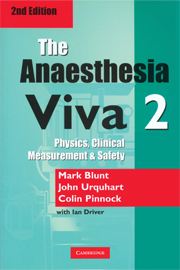Book contents
- Frontmatter
- Foreword to the First Edition
- Preface to the Second Editions
- Contents
- Physics, Clinical Measurement & Safety
- Clinical Anaesthesia
- Example 1
- Example 2
- 6 Example 3
- 7 Example 4
- Example 5
- Example 6
- Example 7
- Example 8
- Example 9
- Example 10
- Example 11
- Example 12
- Example 13
- Example 14
- Appendix 1
- Appendix 2
- Index
Example 14
Published online by Cambridge University Press: 05 February 2015
- Frontmatter
- Foreword to the First Edition
- Preface to the Second Editions
- Contents
- Physics, Clinical Measurement & Safety
- Clinical Anaesthesia
- Example 1
- Example 2
- 6 Example 3
- 7 Example 4
- Example 5
- Example 6
- Example 7
- Example 8
- Example 9
- Example 10
- Example 11
- Example 12
- Example 13
- Example 14
- Appendix 1
- Appendix 2
- Index
Summary
Scenario
You are presented with a 62-year-old man for elective repair of an inguinal hernia. He has always smoked 20+ a day since the age of 14 and has a persistent cough. He denies any other medical problems. The patient asks you if a spinal anaesthetic would be suitable as his friend recently had one. Do you think this is a suitable technique for this patient?
This requires a clinical approach. Take the history, examine, consider.
Begin by getting more detail about the bronchitis, which will surely be present. Sputum, antibiotic use, visits to GP, wheezing and any history of haemoptysis.
Ask for examination findings – likely to have widespread ronchi and perhaps wheeze throughout. Are there any vitalograph results? You may be shown one.
Assuming no acute infection or other complications check next for any contraindications to spinal anaesthesia. Consider:
▪ Anticoagulation
▪ Hypotensive medication
▪ Spinal deformity
▪ Previous laminectomy
▪ Difficult airway
▪ Inability to lie flat
In the absence of contraindications a spinal technique is entirely suitable for a hernia repair if an in patient bed is available. Expect to be asked about the practical technique, needle choice, block height, drugs. Do not forget to administer oxygen on the table and be cautious in patients with respiratory compromise when choosing to sedate or not. Benzodiazepines are particularly unpredictable in their respiratory depressant effects.
- Type
- Chapter
- Information
- The Anaesthesia Viva , pp. 126 - 128Publisher: Cambridge University PressPrint publication year: 2003

